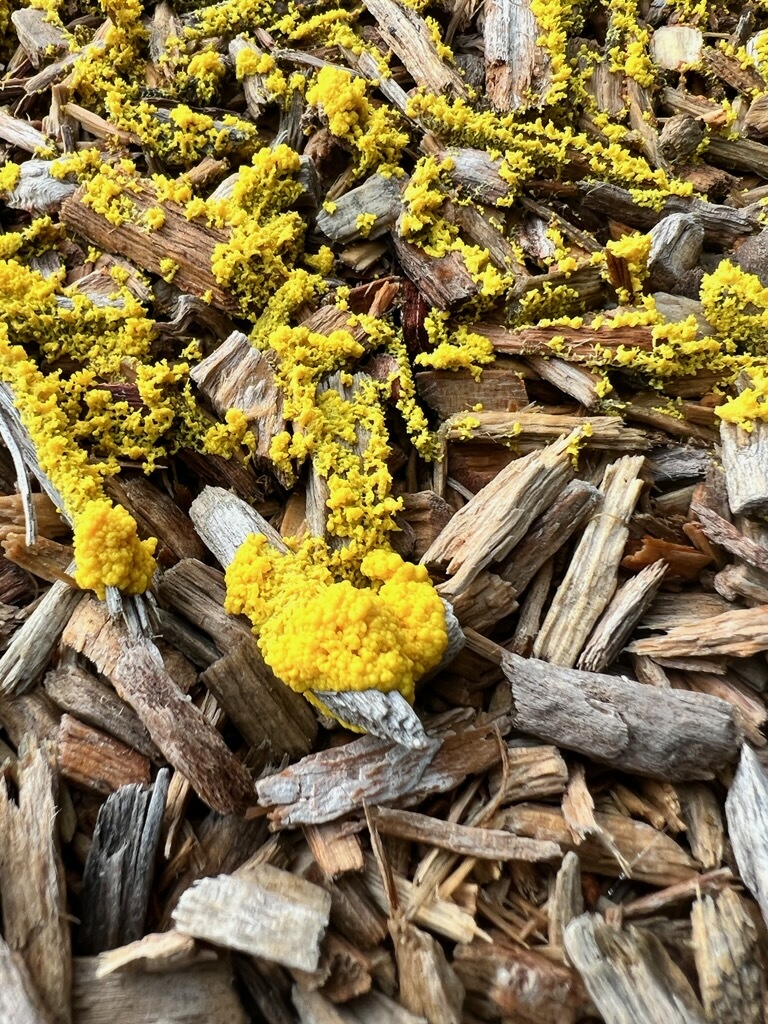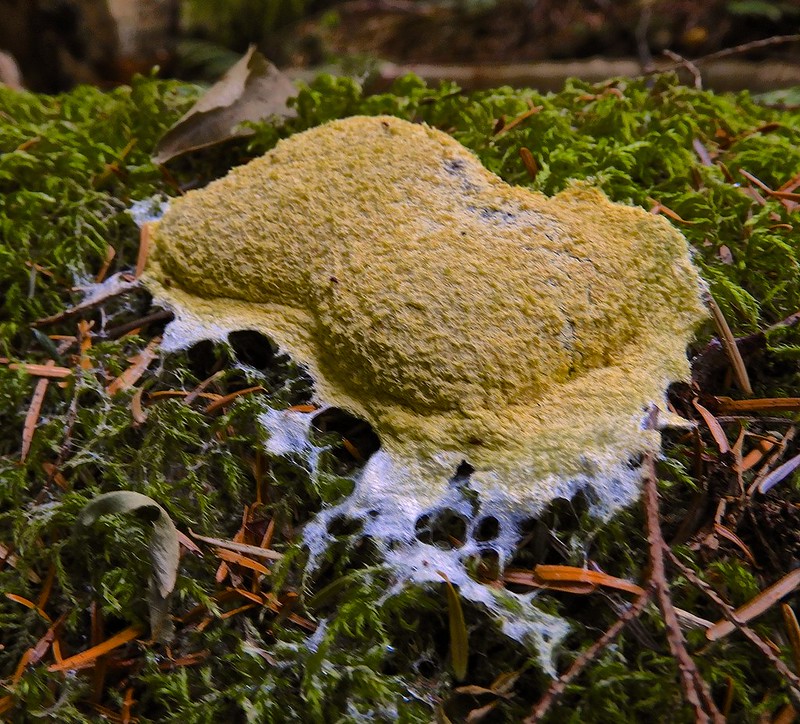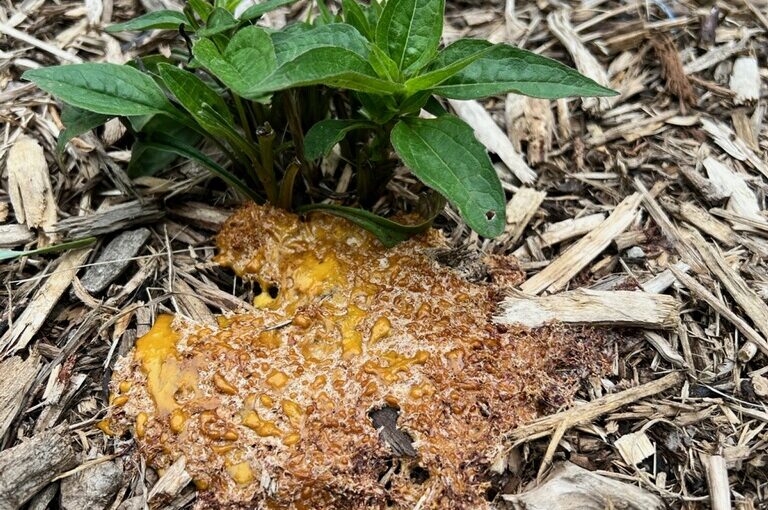It may seem odd to sing the praises of a weird, sometimes gross, looking phenomenon that sometimes freaks gardeners out, but every summer I love educating gardeners about the fascinating lives of slime molds. Here in Nebraska we often get calls about “this weird thing that’s all over my mulch” after a rainy period in the summer and whether or not it will 1) hurt their plants, 2) poison them, or 3) some other horrible outcome they’ve dreamed up. But the fact is, not only are slime molds harmless they’re also quite fascinating. In fact, I’ve often thought if I ever had the right terrarium setup, I’d love to have a pet slime mold. No joke.
What is a slime mold?
Basically speaking, slime molds are a group of eukaryotic organisms similar to amoebae that feed on microorganisms and do some pretty amazing things for simple-celled organisms. They can often be found in soils, forests, especially wetter ones, where they live on the microorganisms that are breaking down fallen logs and detritus on the forest floor. In gardens, you’ll find them in areas with heavy, woody mulches or high organic matter. (They also live in rain gutters if they’re full of leaves and also air conditioner units with poor drainage, FYI.) Most of the calls that we receive at the extension office are from suddenly finding slime mold in woodchip mulch. Usually after a large or extended rain event during the summer, and usually in thickly layered (several inches) mulch.
When food (microorganisms) is abundant, the majority of a slime molds, at least the ones in the “cellular slime mold” category live most of their lifecycle is as a single cell, imperceptible to humans. But when food becomes scarce is when the fun begins. In mulch, this can happen when the weather conditions (wet and hot) favor a slime mold population boom thanks to sexual reproduction and they eat themselves out of house and home. When that happens, the individual cells join together as a single body (one big cell blob with multiple nuclei), forming a visible and for many disconcerting presence in the landscape. Many of them look like actual slime and several look like webbed networks or neural structures.

The most fun thing about slime mold, though, and the thing that I love about them is that THEY MOVE! Yep, you heard that right. These single-celled organisms, that stream together to form a single body, can chemically sense the presence of food in the nearby environment and will change shape (together) to move toward the food. And they’ll follow the food wherever it is – on the ground, up on a plant, into the canopy of a tree, etc. Scientists have demonstrated this by having slime molds solve mazes or even create designs, like the Tokyo subway system, in vitro. The trail of slime that it leaves in its path even relays a chemical signal that it uses to “remember” where it has been so it doesn’t backtrack or go the wrong direction.
Several of our concerned callers call because a slime mold has moved up onto one of their plants and they want to know if 1) it will kill their plant and 2) if it is toxic. Neither of which is the case. But most of our calls happen when our most common slime mold in the area moves onto its next phase of life – spore production.
You see, when environmental conditions change or the slime mold finds a good supply of food it is time to settle down for some good old-fashioned asexual reproduction. The shape and texture of the slime mold changes, usually becoming more pronounced and dryer looking as it produces sporangia that produces spores.

Callers often describe what looks like dog vomit in their landscape, and that’s where our common slime mold gets its name – the Dog Vomit Slime Mold (Fuligo septica).

Shortly after this phase, the collective body of the slime mold will dissipate. Spores will turn into new single-celled organisms that will repeat the process over again.
Can it be stopped or controlled?
First of all, why would you want to stop this fascinating phenomenon in your garden? (I’m kidding). Really, there’s nothing you can do as a control and there really isn’t a need to do so. As I stated earlier, slime molds do no harm to plants and aren’t dangerous for people or pets. If you just don’t like the look of it, you can reduce the likelihood of it popping up in your landscape by reducing the thickness of woodchip mulch (don’t let my GP colleague Linda hear me say that) or reduce irrigation if it is occurring outside of larger rain events.
Otherwise, just enjoy your pet! It won’t hang around for long. The visible, fascinating life of a slime mold is fleeting but exciting. Next time you see a slime mold, check it out! And keep an eye on it to see if it moves or if it progresses through its life cycle – maybe you’ll just develop an appreciation for them, too. And I’m not joking about pet slime molds, someone even wrote a guide to dog vomit slime mold pet care!

Love it! They move! When I was in landscaping, we received this question every spring. If it bothered people, we told them to scoop it up and dispose of it. But like you said, why? So cool!
I love Latin nomenclature…
I added 30 yards of mulch to my property in the last year. I love the stuff. I also have several verities of beautiful mushrooms coming up after the rains, dog poop fungus, and now dog barf slime. My wife is appalled by all this, but I love it. Thanks for the article. I am far more appreciative of slime mold now.
Great article, informative and fun for this novice gardener!